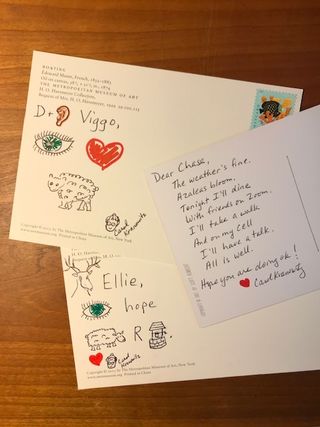
Coronavirus Disease 2019
Postcard Pals
Receiving your brief message through snail mail will make a kid's day.
Posted April 23, 2020

On a tram chugging up to Pike’s Peak in Colorado, I chatted with Chase, a tween with autism. We discovered that we both love rocks. After munching world-famous, high-elevation donuts, we sat together again on the ride down. We compared the rock samples we had scooped up and chose our favorites. A week later, I sent Chase a postcard of the cog railway. To my pleasant surprise, he sent a card in return, and thus we became Postcard Pals.
Another Postcard Pal is Ellie. She lives in Arizona and has sensory processing disorder. In our correspondence, we ask and answer questions: Do you have pets? Where were you born? What makes you feel good? Ellie loves to run, and while she’s cooped up inside during the novel coronavirus crisis, she misses the opportunity to move frequently and fast.
And Viggo, a nimble lad living in California, who does flips and cartwheels on the grass when you’re taking a walk together, tells me he’s really bored and sad that his 5th-grade class won’t have a graduation party. His grown-ups disagree about the best approach to COVID-19. His cats don’t care. “Whatever,” he writes.
Picture postcards were tremendously popular at the turn of the century as a quick means of communication, and people collected them in albums. Today they are a tremendously popular collectible on eBay and other websites because of their historic, aesthetic, and whimsical value. In 2020, when we are physically isolated, postcards can be treasures, reminding us that our go-to people are there for us, keeping us connected in their emotional embrace.

I have been sending postcards to my five grandchildren since they were little. Before they could read, it was often a rebus message, with a sketch of an antlered deer to replace “Dear,” and a heart to replace “Love.” Sometimes the message is a poem, like this opus I composed today:
The sun doth shine,
The sky is blue,
I’m feeling fine,
And I love you.
If you like the idea, here are suggestions for this low-tech, high-satisfaction enterprise:
- Search online for “postcard collections.” You’ll find cityscapes, animal and flower collections, inspirational sayings, fairy tales, Disney, dinosaurs, and other subjects. You can find 30 postcards for about 10 dollars.
- Get postcard stamps for 35¢ each. If going to the Post Office is not an option, you can order a roll of 100 stamps online from the US Postal Service for $35 plus a small postage fee.
- Write a message specifically for the recipient. To a grandson who loves astronomy, I may send a reminder to check out the harvest moon. To the one who loves summer, the postcard picture may be a beach we went to together. The clarinetist gets cards with musical instruments; the artist gets the Impressionists. Today, I sent a card featuring Sigmund Freud to my granddaughter who is home from college and trying hard to study long-distance psychology. (“I can do College,” she says, “and I can do Home, but it’s really hard to do College at Home.”) Maybe a photograph of Dr. Freud at his desk will be inspiring.
- To little kids, send a few lines of a story and call it, “Part I in a series. Keep this card!” Your next card will be Part II, and in a few weeks, they can line up the cards for the whole story.
- Put your address sticker on the card, and you may get a response!
- Even if you don’t get a response, send another card soon. You can be sure the person receiving it will be delighted.
Tangible pieces of snail mail are more welcome than ever in these Stay-at-Home days. And once we are allowed to get out and about again, you may enjoy continuing to grow your collections of postcards and Postcard Pals.

